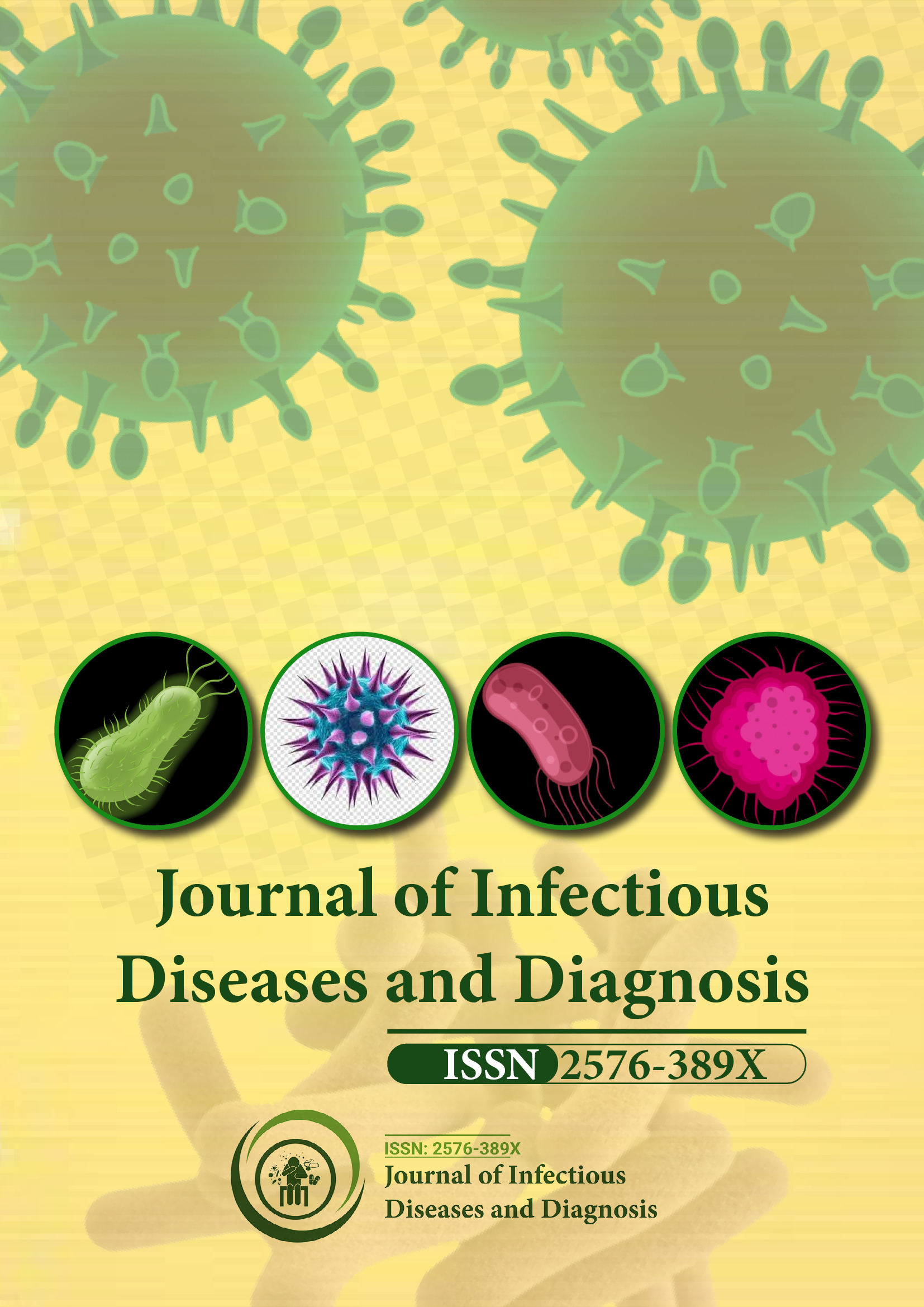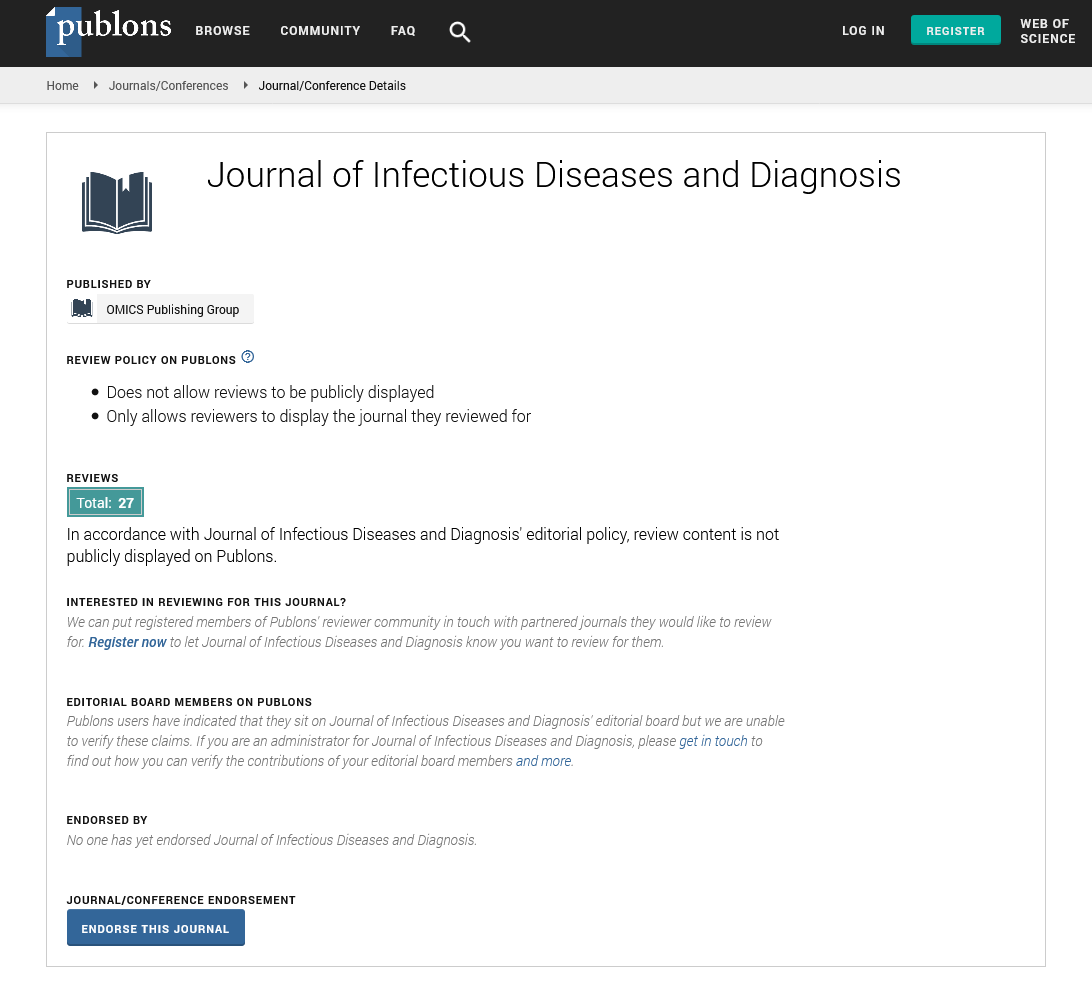Indexed In
- RefSeek
- Hamdard University
- EBSCO A-Z
- Publons
- Euro Pub
- Google Scholar
Useful Links
Share This Page
Journal Flyer

Open Access Journals
- Agri and Aquaculture
- Biochemistry
- Bioinformatics & Systems Biology
- Business & Management
- Chemistry
- Clinical Sciences
- Engineering
- Food & Nutrition
- General Science
- Genetics & Molecular Biology
- Immunology & Microbiology
- Medical Sciences
- Neuroscience & Psychology
- Nursing & Health Care
- Pharmaceutical Sciences
Commentary - (2025) Volume 10, Issue 4
Clinical Infectious Diseases: Challenges and Advances in Diagnosis and Management
David Jennifer*Received: 30-Jun-2025, Manuscript No. JIDD-25-29507; Editor assigned: 03-Jul-2025, Pre QC No. JIDD-25-29507 (PQ); Reviewed: 17-Jul-2025, QC No. JIDD-25-29507; Revised: 24-Jul-2025, Manuscript No. JIDD-25-29507 (R); Published: 31-Jul-2025, DOI: 10.35248/2576-389X.25.10.340
Description
Clinical infectious diseases remain a significant concern for global health, affecting populations across all regions and socioeconomic levels. They encompass a wide spectrum of illnesses caused by bacteria, viruses, fungi and parasites, ranging from mild community-acquired infections to severe systemic diseases. The field of clinical infectious diseases focuses on understanding the pathogenesis of infections, developing diagnostic approaches, applying therapeutic strategies and implementing preventive measures to reduce disease burden. With constant emergence of new pathogens and growing resistance among existing ones, clinicians and researchers face continuous challenges in controlling and treating infectious diseases effectively.
The burden of infectious diseases varies widely depending on geographical location, environmental conditions and healthcare infrastructure. In many low- and middle-income countries, infectious diseases such as malaria, tuberculosis, HIV and diarrheal illnesses still represent leading causes of morbidity and mortality. In higher-income regions, while the prevalence of some communicable diseases has declined due to vaccines and improved sanitation, new threats such as antimicrobial resistance and emerging viral outbreaks continue to create substantial health risks. This global disparity underscores the need for region-specific approaches in diagnosis, treatment and prevention.
One of the defining features of clinical infectious diseases is their ability to spread rapidly within populations. Epidemics and pandemics demonstrate how infectious agents can cross borders and impact global health security. The COVID-19 pandemic, for example, highlighted the importance of coordinated surveillance, early diagnosis and timely public health interventions. Other emerging infections, such as Ebola virus disease, Zika virus and novel strains of influenza, further illustrate the dynamic nature of infectious threats. Understanding the epidemiology and transmission patterns of these diseases is fundamental for designing effective containment and treatment strategies.
Diagnosis of infectious diseases has evolved significantly with advancements in technology. Traditional methods such as culture and microscopy remain widely used and provide valuable information, particularly for bacterial and fungal infections. However, these techniques may be time-consuming and sometimes lack sensitivity. Molecular diagnostics, including Polymerase Chain Reaction (PCR), Next-Generation Sequencing (NGS) and point-of-care tests, have transformed clinical practice by enabling rapid and highly specific identification of pathogens. Serological assays and antigen detection methods also contribute to the timely diagnosis of viral and parasitic diseases. Early and accurate detection not only guides appropriate therapy but also reduces transmission within healthcare and community settings.
Management of infectious diseases relies on antimicrobial therapies, including antibiotics, antivirals, antifungals and antiparasitic agents. While these treatments have saved millions of lives, the growing problem of antimicrobial resistance presents a major challenge. Resistant organisms such as Methicillin-Resistant Staphylococcus Aureus (MRSA), multidrug-resistant tuberculosis and carbapenem-resistant Enterobacteriaceae have limited treatment options and are associated with higher mortality rates. Stewardship programs that promote rational use of antimicrobials, combined with the development of new agents, are essential to address this issue. Alongside pharmacological interventions, supportive care remains an important component of management, particularly in severe infections that cause systemic complications.
Vaccination has been one of the most effective tools in reducing the impact of infectious diseases. Immunization programs have led to significant declines in diseases such as measles, polio and hepatitis B. More recently, vaccines against Human Papillomavirus (HPV) and COVID-19 have further demonstrated the role of immunization in reducing infection-related morbidity and mortality. Continued research into new vaccines for malaria, HIV and other persistent infections holds the potential to transform prevention efforts. However, challenges remain with vaccine access, distribution and public acceptance, particularly in low-resource settings.
Prevention and control strategies for infectious diseases extend beyond vaccination. Public health measures such as sanitation, safe drinking water, improved hygiene and vector control have contributed greatly to reducing transmission. In healthcare facilities, infection prevention practices including hand hygiene, sterilization and isolation protocols play a significant role in limiting hospital-acquired infections. Surveillance systems are equally important, enabling early detection of outbreaks and guiding resource allocation during health emergencies.
The intersection between infectious diseases and other health conditions is another area of clinical importance. Immunocompromised individuals, such as those with cancer, undergoing organ transplantation, or living with HIV, are at increased risk of severe infections. Co-infections, such as tuberculosis in people with HIV, further complicate treatment strategies and require integrated approaches to care. Additionally, climate change, urbanization and global travel are influencing the distribution of infectious diseases, leading to the re-emergence of conditions in areas where they were previously controlled.
Clinical research in infectious diseases continues to expand, addressing areas such as antimicrobial development, host-pathogen interactions, immune response modulation and novel diagnostic platforms. The integration of artificial intelligence and big data analytics into clinical practice also holds potential for improving disease prediction, surveillance and personalized treatment strategies. Collaborative efforts between governments, healthcare providers, academic institutions and industry partners are essential for sustaining progress in this dynamic field.
In conclusion, clinical infectious diseases represent an ongoing challenge to health systems worldwide. Despite advances in diagnostics, therapeutics and preventive measures, new threats continue to emerge and established pathogens adapt through resistance. Effective management requires a combination of clinical expertise, public health strategies, global cooperation and continued research. By addressing these multifaceted challenges, the field of clinical infectious diseases will continue to play an important role in protecting population health and advancing medical science.
Citation: Jennifer D (2025). Clinical Infectious Diseases: Challenges and Advances in Diagnosis and Management. J Infect Dis Diagn. 10:340.
Copyright: © 2025 Jennifer D. This is an open-access article distributed under the terms of the Creative Commons Attribution License, which permits unrestricted use, distribution and reproduction in any medium, provided the original author and source are credited.

